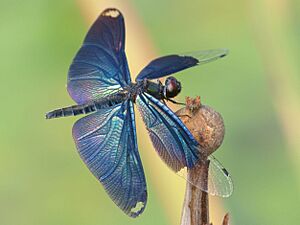Butterfly dragonfly facts for kids
Quick facts for kids Butterfly dragonfly |
|
|---|---|
 |
|
| Male | |
| Conservation status | |
| Scientific classification | |
| Synonyms | |
|
Rhyothemis noshime Asahina, 1982 |
The butterfly dragonfly (Rhyothemis fuliginosa) is a fascinating insect. It is also known as the butterfly flutterer. This type of dragonfly belongs to the family Libellulidae. You can find it across East Asia. This includes countries like Japan, China, Taiwan, and the Korean Peninsula.
In Japan, people call R. fuliginosa チョウトンボ (chou-tonbo). This name means "butterfly dragonfly." In China and Taiwan, it is known as 黑翅蜻蜓 (Hēi chì qīngtíng). This means "black-winged dragonfly." In Korea, its name is 나비잠자리 (Nabi jamjari), which also means "butterfly dragonfly."
These dragonflies usually fly between June and September. They are most active from early summer to mid-autumn.
Contents
What Does It Look Like?
The butterfly dragonfly is a short and strong insect. Its body is about 32 to 41 millimeters long. Its wings spread out about 30 to 40 millimeters.
The wings have a beautiful deep blue, shiny color. This shine is called iridescence. It means the color changes depending on how you look at it. Sometimes, the wings can even look golden in the light. Scientists think these wing patterns help dragonflies find the right partner. This way, they avoid mating with a different species.
Male butterfly dragonflies have special spots. These spots are on the tips of their back wings. This helps you tell the difference between males and females. In southern Japan, some R. fuliginosa have spots on their front wings too. Their back wings are fully colored.
Where Does It Live?
The butterfly dragonfly lives all over East Asia. It has been seen in China, Japan, Taiwan, and the Korean Peninsula. It has also been known to fly further south into Vietnam.
In Japan, you can find this dragonfly on the main island of Honshu. It lives as far north as Aomori Prefecture. It also lives south on the island of Kyushu in Kagoshima Prefecture. Overall, it is found on the islands of Honshu, Shikoku, and Kyushu. There have even been reports of sightings further north in Hokkaido. Its home also includes islands off the Japanese mainland, like Tanegashima.
In Mainland China, R. fuliginosa lives in many provinces. These include Guangdong, Hebei, Henan, Hunan, Jiangsu, Jiangxi, Shaanxi, Shandong, Shichuan, and Zhejiang. There are also some unconfirmed sightings in Hainan province.
It is rare to see this dragonfly in Taiwan. The first time it was seen there was in 2007. Other types of Rhyothemis dragonflies are more common on the island.
What Kind of Home Does It Like?
The butterfly flutterer likes freshwater wetlands. It especially likes areas with lots of aquatic plants. You can find them in places like marshes and swamps. They also live in permanent freshwater lakes and ponds. Sometimes, they live in man-made ponds or fish farms.
You can see them flying in flat plains, hilly areas, and mountains. They also like watersides in satoyama areas. Because they are good at flying, adult R. fuliginosa can go far from their wetland homes. In the evenings, the adults fly into forests. They rest high up in the trees.
What Do They Eat and How Do They Live?
Rhyothemis fuliginosa eats other flying insects. They especially like to eat mosquitoes.
Mating for these dragonflies is quick. The female lays her eggs almost right after mating. She places the eggs on the surface of freshwater. The R. fuliginosa spends winter as a larva. During this time, it eats small insects.
These dragonflies used to fly in large groups. However, their homes have been shrinking. Pollution from insecticides has also caused problems. This has led to a big drop in their numbers in Japan. As cities grow, fewer and fewer butterfly flutterers are seen in city areas.
Why Is It Called That?
The name fuliginosa comes from a Latin word. It means "sooty," like something covered in soot. The first part of the genus name, Rhyothemis, comes from Ancient Greek. Rhyēnai means "having flown." Themis means "customary law." This part of the name is used in many dragonfly names.
The English names, "butterfly dragonfly" and "butterfly flutterer," come from the Japanese language name. This name directly means "butterfly dragonfly." It refers to their wide, shiny wings. It also describes how they fly, which looks a lot like a butterfly. Another similar dragonfly, Rhyothemis variegata, shares this Japanese name. It is called オキナワチョウトンボ (okinawa chou-tonbo), meaning "Okinawa butterfly dragonfly."
Images for kids
-
R. fuliginosa on a lotus.




